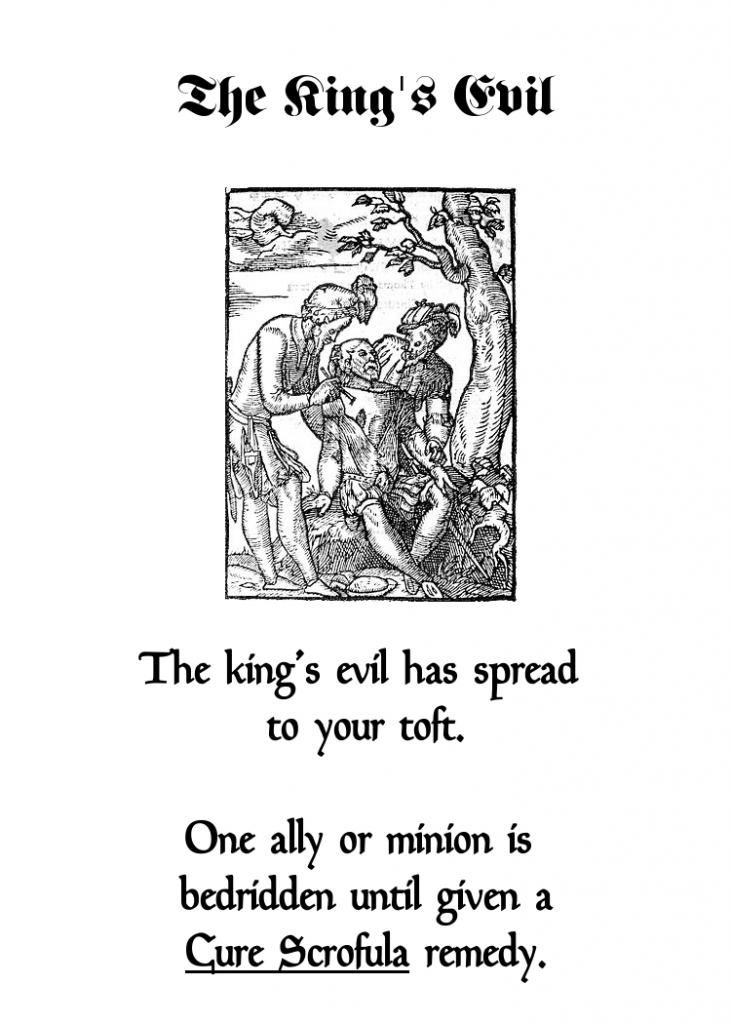Medieval Apothecary

Medieval Apothecary, a card game inspired by the potion-brewing mechanic in Elder Scrolls: Skyrim, took about six months to complete. In Medieval Apothecary, players take on the role of medieval herbalists. Initially, I simply wanted a deck of cards with herbs and their uses to use with Dungeons & Dragons. After creating and using the herb cards, I decided to create a full game.
It is a dedicated deck multi-game with 216 cards. There are three different ways to use the cards: cooperative play (all players contribute to meeting the victory conditions), competitive play (aka head-to-head play), and complementary play (for use with role-playing games). The core mechanic of the game involves gathering herbs (by accumulating cards) and then matching the uses of the herb cards in order to make remedies. Another deck of cards includes random events, items, and people.
Historicity
Unlike Skyrim, this game uses actual herbs discussed in Anglo-Saxon herbal books and follows the actual uses that medieval apothecaries practiced. I compiled the herbs and their uses from four different books into a spreadsheet; had I known the compilation would have 290 herbs and 222+ uses, I would have opted for a database instead. I often had to interpret, compare, or simplify medical uses and names because most plants had multiple names and uses. For instance, the card shown above is for black hellebore, which is known as Christmas rose in different sources and was used to cure sheep murrain – although no one knows what that was. Also, I chose to use historical cures rather than fake game cures because they’re just delightful. Did you know that hassock combats devil sickness or that pennyroyal will protect against dwarves?

Scenarios
Just as using real-world maladies with the herbs made the game seem more medieval, striving for historical authenticity in other ways actually made this game better as well. The initial end-game scenarios simply involved concocting a lot of regular remedies or some powerful remedies. However, to pull players into the medieval world, I concocted story scenarios to emphasize the purpose of the remedies, tie them together with similar remedies, and draw random event cards into the greater story created by the game. Thus, the scenarios had narrative elements relating the gameplay to greater purposes (for instance, protecting locals or curing the leader). Also, by emphasizing different victory conditions, players focused on different remedies and herbs in each playthrough. With five scenarios in each deck, a two-player game has a combination of 25 different endgames.



The scenarios also presented players with dilemmas – should they keep a remedy that fulfills a victory condition or use it to deal with a problem created by an event card? Through the narrative scenarios, the game becomes fully developed, rich with choice and dilemma – and not simply a potion-mixing game.
Appearance
Most games with cards now use bold coloring and often cartoonish illustrations. I chose a more subtle appearance and used historical illustrations whenever possible, drawing on three motifs when designing the appearance of the cards. For the herbs themselves, I used preexisting art from the 17th through 19th centuries, when apothecaries and botanists were studying plants and illustrating their books with watercolors. These books being rather old, the paper had yellowed, so I bleached out the backgrounds for most plant illustrations. The herb card borders draw on the second motif – Victorian floral designs. The final piece for the herb cards was the labeling of the plant name and the remedies they could make. For this, I chose an early-modern broadsheet ascetic, and I made heavy use of woodcuts for illustrating the game decks. However, the choice of an authentic Fraktur font turned out to be too difficult for people to read. The game deck also made use of borders from medieval manuscripts. I made all the cards myself with GIMP.






©2023